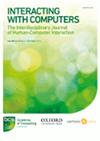Computational Thinking and Mental Models: Promoting Digital Culture in the Youth and Adult Education
IF 1.3
4区 计算机科学
Q3 COMPUTER SCIENCE, CYBERNETICS
引用次数: 1
Abstract
Computational thinking is an ability that has been considered essential for people living in a society mediated by technology. This ability can also be helpful to people with little or no experience with technology, for practicing basic Computational Thinking skills may help understanding how a technological device works and can be used. However, to the best of our knowledge, little research has addressed Computational Thinking and its relation with Digital Culture, especially for reducing the digital divide. In this article, we draw on the notion of Mental Models to relate Computational Thinking and Digital Culture. We claim that practicing basic Computational Thinking skills when exploring simple prototypes favors building Mental Models that are useful to understand and progress in the usage of technologies, contributing to developing a Digital Culture. To situate our discussion, we present a case study that engaged adults, in their initial stages of literacy, in activities that grew from basic ones, with a low-fidelity ATM prototype, to more complex ones with a functional ATM prototype. Evaluation methods used were voting, feedback, structured observation and unstructured interviews. Results suggested our approach is promising as participants gained confidence and increased autonomy as the activities progressed, using the experience and knowledge they obtained from previous activities to perform the next ones.计算思维与心智模式:促进青少年与成人教育中的数位文化
计算思维被认为是生活在以技术为媒介的社会中的人们必不可少的一种能力。这种能力也可以帮助那些很少或没有技术经验的人,因为练习基本的计算思维技能可以帮助理解技术设备是如何工作和使用的。然而,据我们所知,很少有研究涉及计算思维及其与数字文化的关系,特别是减少数字鸿沟。在这篇文章中,我们利用心智模型的概念来联系计算思维和数字文化。我们声称,在探索简单的原型时,练习基本的计算思维技能有助于建立有助于理解和进步技术使用的心智模型,有助于发展数字文化。为了定位我们的讨论,我们提出了一个案例研究,该案例研究涉及成年人,在他们识字的初始阶段,从使用低保真ATM原型的基本活动到使用功能ATM原型的更复杂的活动。评价方法采用投票、反馈、结构化观察和非结构化访谈。结果表明,我们的方法是有希望的,因为随着活动的进行,参与者获得了信心和自主权,利用他们从以前的活动中获得的经验和知识来执行下一个活动。
本文章由计算机程序翻译,如有差异,请以英文原文为准。
求助全文
约1分钟内获得全文
求助全文
来源期刊

Interacting with Computers
工程技术-计算机:控制论
CiteScore
2.70
自引率
0.00%
发文量
12
审稿时长
>12 weeks
期刊介绍:
Interacting with Computers: The Interdisciplinary Journal of Human-Computer Interaction, is an official publication of BCS, The Chartered Institute for IT and the Interaction Specialist Group .
Interacting with Computers (IwC) was launched in 1987 by interaction to provide access to the results of research in the field of Human-Computer Interaction (HCI) - an increasingly crucial discipline within the Computer, Information, and Design Sciences. Now one of the most highly rated journals in the field, IwC has a strong and growing Impact Factor, and a high ranking and excellent indices (h-index, SNIP, SJR).
 求助内容:
求助内容: 应助结果提醒方式:
应助结果提醒方式:


